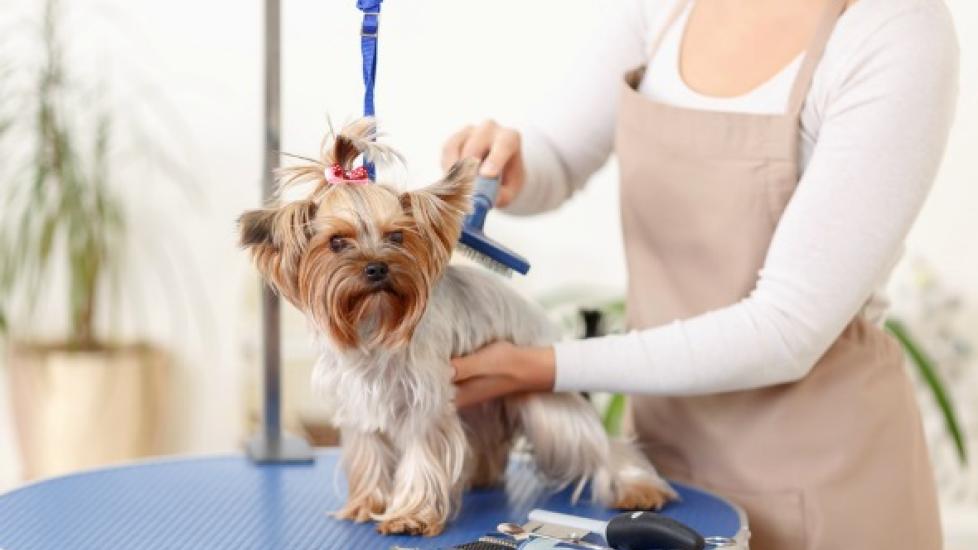Safety Tips for the Professional Groomer
By T. J. Dunn, Jr., DVM
Let's face it, dogs (and cats) are potentially dangerous -- especially when you get all up and personal with them. So it shouldn't be much of a surprise that you, as a groomer, must practice utmost care when you are clipping a pet here and trimming there. Here are a few tips and techniques ...
Personal Safety
Watch closely how the dog and owner interact, and heed any warnings the owner may give you about such things as "Don't touch her near her hips or she'll bite" or "He doesn't like quick movements near his ears." Of course you will need to work on and around those areas, but the owner knows something about that animal's protected areas, and you need to pick up on that hint, so pay attention.
Since you can't predict when things may go awry, have bite-proof gloves handy. There are also a number number of muzzle styles and sizes available for the truly anxious or vicious animals.
Here's an easy yet rarely practice one: If you have a pet that you feel is dangerous to you or anyone around your facility, you DO NOT have to groom it. Call the owner and relate in non critical terms the simple fact that you cannot risk injury and loose time from work if their pet hurts you.
You might also state that despite attempts on your part, their pet will not tolerate the things you need to do in order to have a satisfied customer and a good job of grooming done. This will typically incite two reactions:
1. "Well, I really didn't think you would be able to handle him. You are the fourth groomer who has had trouble. I'm sorry; I'll come and get him."
2. "What are you talkin' about? You must have scared him; he's never acted like that at any other groomers'. You aren't going to charge me anything, are you?"
Then there are the state laws and regulations. Read up and abide by them. They range in usefulness and complexity, but should help you maintain proper safety.
Speaking of which, a few other things to watch out for include slipping on wet floors, back strains, electrical shocks, eye trauma, loss of hearing, flat feet, fires, and (if you're living in certain areas) floods and hurricanes.
Gosh, maybe working in a library would be a good career choice.
Pet Safety
Never ... let me repeat, NEVER let a pet get out of your control. If, however, you'd like nothing better than to incite a raucous, allow the pet to roam your grooming facility freely. Eventually someone will open the wrong door at the wrong time and the pet will disappear.
What will you tell the owner then? Surely there is nothing to say, as it will be your fault.
Continuous, gentle and secure restraint should be on your mind all the time, especially when pet is on the grooming table. The grooming arm should have a loop with a quick release in case you need to disconnect the pet quickly.
Make it a firm habit to place the pet into a cage every single time you have to leave the grooming room. And when placing the pet into a cage, be sure of your grip. Dogs and cats often anticipate your placement and jump at the last second. This can lead to an uncertain landing. (I worked at an animal hospital where a dog broke his leg in one such unlikely landing!) A sure grip will prevent an unexpected escape from your control.
Dryers may just as likely be your best friend as your worst enemy. Regulating the temperature and avoiding electrical connection issues are just some of the caveats of these machines. In addition, it is important the animal is thoroughly dry before it goes home. Just a little soapy moisture on the skin can lead to moist eczema, known as a hot spot. Watch the pet for any signs of discomfort or anxiety and don't leave the dryer on any longer than necessary.
Lastly, take precautions whenever you are clipping, scissoring or brushing near the eyes. I've seen some very scary near-misses with those wire brushes whizzing past the open eyes of pets. Cutting mats from a cat or dog takes patience and you will be very surprised when you slice a crescent shape gash into a pet just below that tight fur mat. Eye, ear, skin and secure restraint precautions should always be priorities.
Of course there are countless other safety tips to bear in mind, but these are great starter points. I hope you enjoy the wonderful world of animal grooming.
